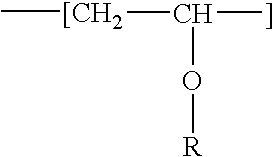Fat-binding polymers
a polymer and fat-binding technology, applied in the field of fat-binding polymers, can solve the problems of serious side effects resulting from the administration of lipase inhibitors, such as steatorrhea or fatty stool, and achieve the effect of excellent fat-binding properties and low toxicity
- Summary
- Abstract
- Description
- Claims
- Application Information
AI Technical Summary
Benefits of technology
Problems solved by technology
Method used
Image
Examples
example 1
Poly((3-acrylamidopropyl)trimethylammonium chloride-co-acrylamide-co-N-decylacrylamide) Mol % monomer composition: 25 / 70 / 5
[0150]A 250-mL round-bottomed flask was fitted with an overhead stirrer, a reflux condenser, and a thermocouple probe. The following materials were placed into the flask in the order specified: a solution of decylacrylamide (2.83 g, 0.0134 mole) in tert-butanol (45 mL), 3-acrylamidopropyltrimethylammonium chloride (18.45 g of a 75 percent solution in water, 0.067 mole), deionized water (40 mL), and acrylamide (13.33 g, 0.1875 mole). The resulting mixture was stirred and heated to 50° C. A clear, slightly yellow solution resulted. The solution was sparged for at least 30 minutes with a vigorous nitrogen flow from an 18-gauge syringe needle whose tip was placed below the surface of the stirring solution. The radical initiator 2,2′azobis(2-amidinopropane) dihydrochloride (0.363 g, 0.00134 mole) was then added to the solution and the temperature was increased to 60° ...
example 2
Poly((3-acrylamidopropyl)trimethylammonium chloride-co-acrylamide-co-N-decylacrylamide) Mol % monomer composition: 25 / 65 / 10
[0151]The procedure of example 1 was followed substituting the following materials and amounts: decylacrylamide (5.33 g, 0.0252 mole), 3-acrylamidopropyltrimethylammonium chloride (17.37 g of a 75 percent solution in water, 0.063 mole), deionized water (40.5 mL), acrylamide (11.65 g, 0.1638 mole), 2,2′azobis(2-amidinopropane) dihydrochloride (0.342 g, 0.00126 mole). The amount of polymer obtained was 30.7 g.
example 3
Poly((3-acrylamidopropyl)trimethylammonium chloride-co-acrylamide-co-N-decylacrylamide) Mol % monomer composition: 25 / 60 / 15
[0152]The procedure of example 1 was followed substituting the following materials and amounts: decylacrylamide (7.55 g, 0.0357 mole), 3-acrylamidopropyltrimethylammonium chloride (16.4 g of a 75 percent solution in water, 0.060 mole), deionized water (41 mL), acrylamide (10.15 g, 0.1428 mole), 2,2′azobis(2-amidinopropane) dihydrochloride (0.332 g, 0.00119 mole). The amount of polymer obtained was 25.6 g.
PUM
| Property | Measurement | Unit |
|---|---|---|
| temperature | aaaaa | aaaaa |
| temperature | aaaaa | aaaaa |
| mol % | aaaaa | aaaaa |
Abstract
Description
Claims
Application Information
 Login to View More
Login to View More - R&D
- Intellectual Property
- Life Sciences
- Materials
- Tech Scout
- Unparalleled Data Quality
- Higher Quality Content
- 60% Fewer Hallucinations
Browse by: Latest US Patents, China's latest patents, Technical Efficacy Thesaurus, Application Domain, Technology Topic, Popular Technical Reports.
© 2025 PatSnap. All rights reserved.Legal|Privacy policy|Modern Slavery Act Transparency Statement|Sitemap|About US| Contact US: help@patsnap.com



